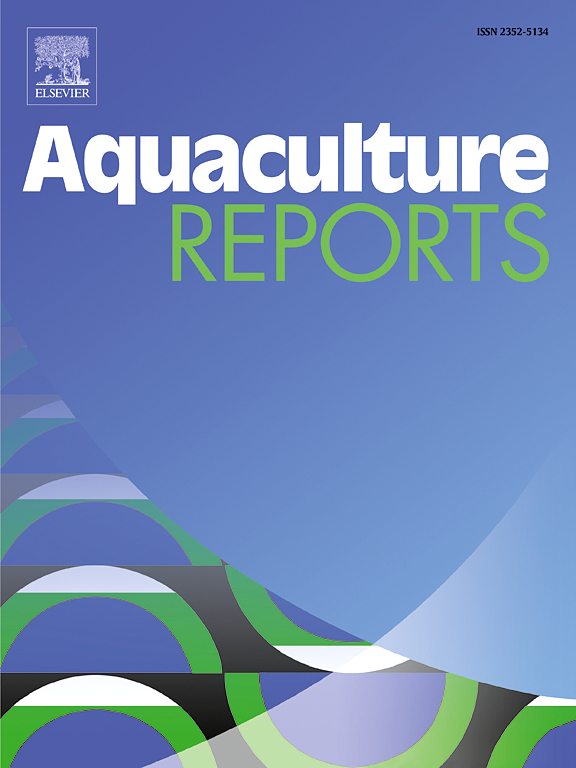用美国鲈鱼粉替代鱼粉对鲑鱼生长、新陈代谢、肠道健康和抗嗜水气单胞菌能力的影响
IF 3.2
2区 农林科学
Q1 FISHERIES
引用次数: 0
摘要
我们进行了一项为期 8 周的养殖实验,以研究用 Periplaneta americana 粉(PAM)部分替代鱼粉(FM)对大口鲈(Micropterus salmoides)的生长性能、身体成分、血清生化指标、肠道健康和对嗜水气单胞菌(Aeromonas hydrophila)的抵抗力的影响。将初始体重(IBW)为 14.55±0.09 g 的 450 尾健康大口鲈鱼随机分为五组。分别用 PAM 取代基础日粮中 0 % (P0)、15 % (P15)、30 % (P30)、45 % (P45) 和 60 % (P60) 的饲料。结果表明,与对照组相比,P15 和 P30 组的最终体重(FBW)、增重率(WGR)和特定生长率(SGR)均无显著差异(P > 0.05)。在所有 PAM 组中,全鱼体粗蛋白明显增加,粗脂肪明显减少(P< 0.05)。P30 组的抗氧化酶活性明显高于对照组和其他实验组,丙二醛(MDA)明显降低(P < 0.05)。α-淀粉酶和胃蛋白酶的活性在 P15 和 P30 显著升高,在 P45 和 P60 显著降低(P < 0.05)。除 P15 组外,各组脂肪酶均明显高于对照组(P < 0.05)。绒毛高度(VH)、隐窝深度(CD)和肌层厚度(MT)在各组间无明显差异(P > 0.05),但绒毛宽度(VW)在 P45 和 P60 显著下降(P < 0.05)。IL-10和TGF-β1的相对表达先上调后下调,而IL-8则相反(P< 0.05)。Casp3、Casp9 和 IFN-γ 的相对表达在 P45 和 P60 显著上调(P < 0.05)。注射蚜蝇后,各组大口鲈均出现死亡,但 P30 的累积死亡率最低。总之,PAM 可以部分替代幼年大口鲈鱼食物中的 FM。替代量不超过 30% 不太可能对生长性能产生不利影响,而且可以增加整个鱼体的粗蛋白含量,对肠道健康有益。本文章由计算机程序翻译,如有差异,请以英文原文为准。
Effects of dietary fish meal replacement by Periplaneta americana meal on growth, metabolism, intestinal health and resistance against Aeromonas hydrophila of Micropterus salmoides
An 8-week culture experiment was conducted to investigate the effects of partial replacement of fish meal (FM) with Periplaneta americana meal (PAM) on growth performance, body composition, serum biochemical parameters, intestinal health and resistance against Aeromonas hydrophila of largemouth bass, Micropterus salmoides. A total of 450 healthy largemouth bass with an initial body weight (IBW) of 14.55±0.09 g were randomly divided into five groups. Five experimental diets were prepared by replacing 0 % (P0), 15 % (P15), 30 % (P30), 45 % (P45) and 60 % (P60) of the FM in the basal diet with PAM, respectively. The results showed that final body weight (FBW), weight gain rate (WGR), and specific growth rate (SGR) were no significant difference in P15 and P30 compared with the control group (P > 0.05). Crude protein of whole fish body was significantly increased and crude lipid was significantly decreased in all PAM groups (P < 0.05). In the P30, the antioxidant enzyme activities were significantly higher than those in the control and other experimental groups, and malondialdehyde (MDA) was significantly decreased (P < 0.05). The activities of α-amylase and pepsin increased significantly in P15 and P30 and decreased significantly in P45 and P60 (P < 0.05). Lipase was significantly increased in all groups except P15 than in the control group (P < 0.05). There were no significant differences in villus height (VH), crypt depth (CD), and muscle thickness (MT) among all groups (P > 0.05), but villus width (VW) was significantly decreased in P45 and P60 (P < 0.05). The relative expression of IL-10 and TGF-β1 were first up-regulated and then down-regulated, while IL-8 was opposite (P < 0.05). The relative expression of Casp3, Casp9 and IFN-γ were significantly up-regulated in P45 and P60 (P < 0.05). After injecting A. hydrophila, all groups of largemouth bass experienced mortality, but cumulative mortality was lowest in the P30. In conclusion, PAM can partially replace FM in the diet of juvenile largemouth bass. The replacement of no more than 30 % is unlikely to adversely affect growth performance, and can increase the crude protein content of the whole fish body, and is beneficial to intestinal health.
求助全文
通过发布文献求助,成功后即可免费获取论文全文。
去求助
来源期刊

Aquaculture Reports
Agricultural and Biological Sciences-Animal Science and Zoology
CiteScore
5.90
自引率
8.10%
发文量
469
审稿时长
77 days
期刊介绍:
Aquaculture Reports will publish original research papers and reviews documenting outstanding science with a regional context and focus, answering the need for high quality information on novel species, systems and regions in emerging areas of aquaculture research and development, such as integrated multi-trophic aquaculture, urban aquaculture, ornamental, unfed aquaculture, offshore aquaculture and others. Papers having industry research as priority and encompassing product development research or current industry practice are encouraged.
 求助内容:
求助内容: 应助结果提醒方式:
应助结果提醒方式:


